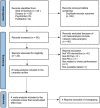Efficacy of virtual reality training on motor performance, activity of daily living, and quality of life in patients with Parkinson's disease: an umbrella review comprising meta-analyses of randomized controlled trials
- PMID: 37777748
- PMCID: PMC10544145
- DOI: 10.1186/s12984-023-01256-y
Efficacy of virtual reality training on motor performance, activity of daily living, and quality of life in patients with Parkinson's disease: an umbrella review comprising meta-analyses of randomized controlled trials
Abstract
Objective: There are several meta-analyses of randomized controlled trials (RCTs) demonstrating the benefits of virtual reality (VR) training as an intervention for motor performance, activity of daily living (ADL) and quality of life (QoL) outcomes in patients with Parkinson's disease (PD). However, the aggregate evidence collected to date has not been thoroughly evaluated for strength, quality, and reproducibility. An umbrella review from published meta-analyses of RCTs was conducted to evaluate the strength and quality of existing evidence regarding the efficacy of VR training in improving the motor performance, ADL and QoL outcomes of patients with PD.
Methods: PubMed, PsychInfo, Web of Science, and Scopus were searched to identify relevant meta-analysis of RCTs examining the effects of VR training on motor performance and quality of life outcomes in PD patients. We recalculated the effect sizes (Hedges'g) for VR training using DerSimonian and Laird (DL) random effects models. We further assessed between-study heterogeneity, prediction interval (PI), publication bias, small-size studies, and whether the results of the observed positive studies were better than would be expected by chance. Based on these calculations, the quality of evidence for each outcome was assessed by using the Grading of Recommendations, Assessment, Development, and Evaluations (GRADE) criteria.
Results: Four meta-analysis with eight outcomes included in the umbrella review was recalculated effect size. Pooled results found VR training can large improve the basic balance ability, moderate improve the overall balance capacity and moderate improve the stride length in PD patients. For ADL and QoL, the effect sizes were pooled that suggested VR training can moderate improve ADL and QoL for PD patients. However, no statistically clear evidence was found in walking speed, motor function and gait function during VR training. The analyzed meta-analyses showed low-to-moderate methodological quality (AMSTAR2) as well as presented evidence of moderate-to-very low quality (GRADE). Tow adverse reactions were reported in the included meta-analyses.
Conclusions: In this umbrella review, a beneficial correlation between VR and balance ability, stride length, ADL and QoL in PD patients was discovered, especially for the very positive effect of VR on balance because of two of the eight outcomes related to balance ability showed large effect size. The observations were accompanied by moderate- to very low-quality rating evidence, supporting VR training as a practical approach to rehabilitation.
Keywords: Activity of daily living; Motor performance; Parkinson's disease; Quality of life; Virtual reality training.
© 2023. BioMed Central Ltd., part of Springer Nature.
Conflict of interest statement
The authors declare that they have no competing interests.
Similar articles
-
Effects of virtual reality rehabilitation training on gait and balance in patients with Parkinson's disease: A systematic review.PLoS One. 2019 Nov 7;14(11):e0224819. doi: 10.1371/journal.pone.0224819. eCollection 2019. PLoS One. 2019. PMID: 31697777 Free PMC article.
-
The effectiveness of virtual reality for rehabilitation of Parkinson disease: an overview of systematic reviews with meta-analyses.Syst Rev. 2022 Mar 19;11(1):50. doi: 10.1186/s13643-022-01924-5. Syst Rev. 2022. PMID: 35305686 Free PMC article. Review.
-
A systematic review and meta-analysis on the effect of virtual reality-based rehabilitation for people with Parkinson's disease.J Neuroeng Rehabil. 2023 Jul 20;20(1):94. doi: 10.1186/s12984-023-01219-3. J Neuroeng Rehabil. 2023. PMID: 37475014 Free PMC article.
-
Effect of virtual reality rehabilitation on functional outcomes for return-to-work patients with Parkinson's disease: An umbrella review of systematic reviews.NeuroRehabilitation. 2022;51(2):201-211. doi: 10.3233/NRE-220029. NeuroRehabilitation. 2022. PMID: 35599505
-
Virtual Reality Interventions for Older Adults With Mild Cognitive Impairment: Systematic Review and Meta-Analysis of Randomized Controlled Trials.J Med Internet Res. 2025 Jan 10;27:e59195. doi: 10.2196/59195. J Med Internet Res. 2025. PMID: 39793970 Free PMC article.
Cited by
-
Safety of Immersive Virtual Reality for the Management of Parkinson's Disease.Sensors (Basel). 2024 Dec 22;24(24):8188. doi: 10.3390/s24248188. Sensors (Basel). 2024. PMID: 39771922 Free PMC article. Clinical Trial.
-
Research progress on the application of anti-gravity treadmill in the rehabilitation of Parkinson's disease patients: a mini review.Front Neurol. 2024 May 31;15:1401256. doi: 10.3389/fneur.2024.1401256. eCollection 2024. Front Neurol. 2024. PMID: 38882698 Free PMC article. Review.
-
Exercise, Neuroprotective Exerkines, and Parkinson's Disease: A Narrative Review.Biomolecules. 2024 Sep 30;14(10):1241. doi: 10.3390/biom14101241. Biomolecules. 2024. PMID: 39456173 Free PMC article. Review.
-
Efficacy of virtual reality exercise in knee osteoarthritis rehabilitation: a systematic review and meta-analysis.Front Physiol. 2024 Jun 19;15:1424815. doi: 10.3389/fphys.2024.1424815. eCollection 2024. Front Physiol. 2024. PMID: 38962070 Free PMC article.
-
Comparison of Occupational Performance in Immersive Virtual and Real Environments Among Patients With Stroke: Observational Randomized Crossover Pilot Study.JMIR Serious Games. 2024 Nov 15;12:e58388. doi: 10.2196/58388. JMIR Serious Games. 2024. PMID: 39545803 Free PMC article.
References
Publication types
MeSH terms
LinkOut - more resources
Full Text Sources
Medical
Research Materials
Miscellaneous


